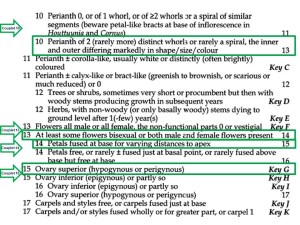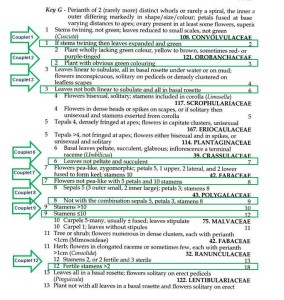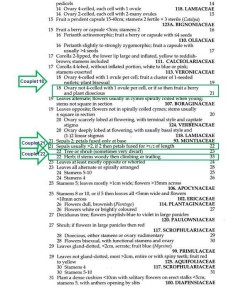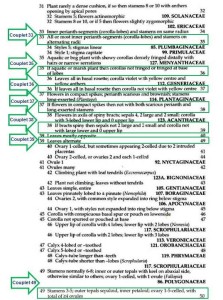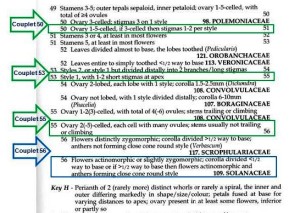Recently, Dr M set his MSc Plant Diversity and SISS students what he likes to call “The Stace test” – a couple of plants provided by Dr M for his students to key out using the general key to families and then moving on to the detailed keys to ID to genus and species.
The first task, as with any plant ID, is to check the plant carefully, especially the floral parts, noting important features such as the number of perianth whorls (e.g. petals and sepals), numbers of stamens and stigmas, details of the ovary position (superior or inferior) etc.
Once the main details of the plant have been checked, the next step is to open the key and to set off on your botanical journey.
The Stace key is a dichotomous key and so the journey proceeds through a sequence of paired questions or couplets.
At each step you must read the pair of couplets carefully (checking any unfamiliar terms) and then decide which option best fits the plant, and then move on to the next couplet as indicated in the key.
It is very useful to note down each numbered couplet on the way (like noting which roads you cross in a car journey). In this way you can track progress of the journey through the key and if you are not convinced with the answer you get, you can retrace the steps and try a different journey!
Also Dr M can use the numbered list to check students’ work to see how they arrived at their answer, and, if they got a wrong answer, check exactly where they went wrong.
Marking the Stace test is a bit like marking a maths problem. You get a mark for the right answer but lots of marks for how you worked out the answer.
So, if a student takes most of the correct steps through the key, but makes a wrong decision near the end, they can score high marks. It’s like not reaching the intended destination but ending up in the village just next door!
The featured image at the top of this post shows one of the plants from Dr M’s first Stace test of the term.
Here are some more:
- Flower – five fused white petals, 5 stamens and 1 stigma
- Calyx tube with 5 teeth (so formed from 5 fused sepals)
- Single stigma and style
- Ovary cut open to reveal ovules (faintly discernible)
Now looking at these images we can compile an inventory of the main features of this plant.
As said already, we do this BEFORE we even open the key, so we get a good, (hopefully) accurate impression of the plant and its flowers BEFORE we embark on the journey through the key – accurate plant ID is not for the impatient!
- The perianth is of 2 whorls and these are different – there is a white corolla of 5 fused petals and green calyx of 5 fused sepals.
- The flowers are bisexual – both male (5 stamens) and female (1 stigma) parts are clearly visible.
- The ovary is superior (the calyx and corolla are inserted below the ovary).
Now on to the carpels, and this is what tends to bemuse many of Dr M’s students, what exactly is the individual carpel, how many carpels are there in a flower and are they free or fused?
So many question so little time to answer them!
But we’ve done so well, we must persevere with these last questions before moving on to using the key.
So let’s start with some definitions:
- Carpel: the basic female unit of the flower, bearing 1 or more ovules, a stigma and (sometimes) a style.
- Ovary: the basal portion of a carpel or group of fused carpels, enclosing the ovule(s).
- Ovule: the organ in the ovary which becomes a seed after fertilisation.
- Fruit: after fertilisation the ovary develops into the fruit which is the seed-bearing structure formed from the ripened ovary after flowering.
- Ripening fruit
- Longitudinal section showing receptacle and numerous ovules
- Transverse section showing numerous ovules
So for our plant we can see the carpel which has a single stigma with the ovary at its base, which is superior and contains a number of ovules.
Now if we can’t make out the ovules from the flower, because it is rather small, we can check the section of the fruit which is much bigger and where we can see numerous ovules (developing seeds).
So now we have enough information to open the key and begin stage 1 of our ID journey through Stace’s general key to families.
Now as Dr M has explained in post #1 of this trio, we can move straight to couplet 10 (page 57).
Click on the image below to see the steps from couplet 10 onwards:
Having checked the flower carefully already this is not as challenging as it might first seem: couplet 10 asks about the perianth and our flower has a perianth of 2 distinct whorls (petals and sepals), this takes us to couplet 13 which asks about the flowers, ours has bisexual flowers so this takes us to couplet 15 which asks about the ovary, our plant has a superior ovary which takes us to Key G!
A very good start!
So for the next stage of the journey we turn to Key G (page 68).
The images below show the journey through the relevant couplets in Key G, click on the images to follow the journey. The “c” numbers in the text refer to the relevant couplets.
Page 68: From the couplets on this page we are ruling out Fabaceae (c7: the flower is not pea-like), Polygalaceae (c8: the flower does not have unequal sepals etc), and our flower has 5 stamens (so fewer than ten (c9) and more than two (c12). We move on to the next page…
Page 69: On this page, key issues are that the ovary in our flower is not 4-celled with 1 ovule per cell (c18: we can see many ovules), again we are asked about sepals (c21: we have 5, so more than 2) and the plant is herbaceous (c22). Some students weren’t sure about whether our plant was herbaceous or woody, and for beginners this can seem tricky. Our plant certainly has tough stems, but are they woody? The answer is no, to be woody there must be secondary thickening so in a woody plant of any age there will be obvious annual rings if we cut a transverse section of the stem, in our plant there are no such rings and so it is a herbaceous plant. Onto the next page…
Page 70: Here we need to check whether the petals are alternately positioned with the stamens or if they coincide (c33), in our plant they alternate, our plant is not an aquatic plant (c35), it has leaves on the stem and not in a basal rosette (c36), the flowers are not in compact spikes (c37), it does not have spiny bracts (c38), the leaves are alternate (c39) and stamens (again!) 3-5, and ovary with more than 4 ovules (c49).
Page 71 – the last page of key G, nearly there? yay!
The ovary is not obviously 3 celled and there is one stigma (c50), and 1 style (c53), the ovary has many ovules (c55, Key G is keen on ovules!) and the flowers are actinomorphic with anthers forming a close cone around the the style (which is hidden by them).
This couplet is the last in Key G and brings us to a possible answer: SOLANACEAE the tomato Family. Its a good call, but to be sure we need to turn to the genus (#109 on page 570) and read the description.
Solanaceae is an economically important family of crops, medicinal plants, spices, weeds, and ornamentals. It’s a beautiful, important but also dangerous family as many members contain potent alkaloids and some are highly toxic such as the aptly named Deadly Nightshade (Atroppa belladonna). Globally there are 98 genera and 2,700 species, with a great diversity of geographical range (all continents except Antarctica and with the greatest diversity in species in South and Central America) morphology and ecology.
Dr M says: We are now in a position to use the the keys to genera and species to complete our ID of this plant which has been patiently waiting to be named for a while now
The next post in this series (here) completes the ID to genus and species.









